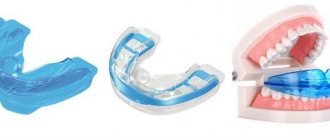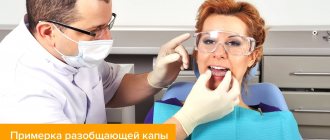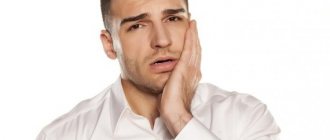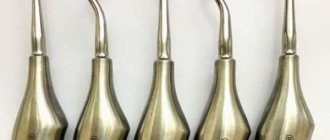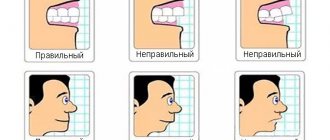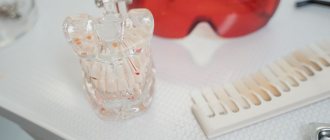A dental trainer is an orthodontic device designed to eliminate the causes of dental anomalies in children and adults. This device is made in the form of a mouthguard and is made of elastic silicone. The trainer's operating mode is quite mild, the device does not need to be worn all the time; it is enough to use it during the day, from one to three hours, and put it on during night sleep. What is a trainer
A trainer is a ready-made orthodontic device that does not require a cast of the jaw during manufacturing. It is produced in one universal size and requires virtually no adjustment, except in cases where it is necessary to trim the ends to fit the length of the jaw.
Trainer design features:
- It has arched recesses for the dentition.
- Equipped with a special “tongue” that fixes the natural position of the tongue.
- Has lip bumpers that relieve muscle pressure.
- In the trainer, the jaw is in its natural position, i.e. in an ideal bite.
When a doctor recommends correction with trainers
Trainers are used to straighten teeth when a patient is diagnosed with a malocclusion. Pathology can have different manifestations, so the possibility of wearing a corrector to obtain an effective result is assessed by the orthodontist individually for each patient.
In certain cases, trainers can replace a brace system if they have contraindications to wearing it. However, the corrective abilities of trainers are inferior to braces, although only slightly.
Other indications for wearing orthodontic trainers:
- deviation in tooth growth (location, direction, etc.);
- swallowing dysfunction;
- pathologies of the oral cavity leading to chronic nasal congestion.
The peculiarity of the device lies in its effect on the cause of the disease. Wearing trainers helps develop the jaw muscles, reduce pressure on the jaw bones, restore breathing through the nose and correct tongue position.
Patient reviews
“Trainers are a very good way to remove slight crooked teeth, as it turns out. Having made an appointment, I expected to wear braces or aligners for a long time, but in the end I completely straightened my teeth in a fairly comfortable and budget-friendly way. Thank you to the doctors at the clinic for suggesting this method, which I had never heard of before.” Kirill, 26 years old
“My child had a not very good habit of sucking his fingers, and an incorrect bite had even begun to form because of this. At the dentist's appointment, trainers were recommended. At first, I doubted the effectiveness because I didn’t notice any significant changes. A few months later, in addition to the fact that my son got rid of his bad habit, I began to notice that his teeth were gradually falling into place. After another six months, she noted that the dentition had completely straightened out. I’m very pleased with the result and thanks to the doctors at the clinic.” Oksana, 45 years old
“I noticed the displacement of my daughter’s teeth too late, so I began to prepare for long-term wearing of braces. But the doctor advised me to use trainers while the bite is changing. The main task was not to aggravate the situation. But I must say that after 8 months of wearing it, my daughter’s teeth began to look much better. I would also like to note the absence of unpleasant sensations when wearing them, since my daughter calmly put on the trainers every day and was not afraid to walk in them.” Marina, 40 years old
Conclusion: Trainers are specific orthodontic structures for correcting minor bite defects or preventing their formation. They are used mainly in children, but can also be used in adults. Dentists at the Smile clinic offer effective treatment with trainers according to indications with a guarantee of a positive result.
For whom are they contraindicated?
Correction with an orthodontic device to correct the bite may not always be carried out. Experts advise postponing the start of treatment in case of exacerbation of chronic diseases, especially those associated with impaired nasal breathing.
There are no significant contraindications. In addition to the listed limitations, treatment is not recommended for lateral crossbite. In case of hyperactivity and uncontrolled behavior of a child, correction takes place under the strict supervision of parents and a doctor.
If there are contraindications, you can choose another method of correcting the bite. Based on the clinical picture and characteristics of the child’s psycho-emotional behavior, the clinic’s specialists will select the most effective system that will not pose any risks to the child’s health.
Indications and contraindications
Main indications for use of the trainer:
- deformation of the dentition due to bad habits;
- deep bite, cramped teeth;
- malocclusion in the anterior region;
- collection of teeth in the frontal region of the lower jaw;
- difficulty swallowing, speech defects, etc.
List of contraindications to the use of trainers:
- pronounced crossbite, when the frontal incisors of the mandibular row are located in front of the upper teeth;
- crossbite in the lateral areas;
- mental problems;
- difficulty breathing with a severe runny nose.
Advantages
An orthodontic trainer is a product similar in appearance to mouth guards. The device is made of polyurethane or silicone.
Advantages of correction using mouth guards-trainers:
- in terms of their effectiveness they are not inferior to braces (with the exception of complex bite pathologies);
- do not require round-the-clock wearing;
- installed for only a few hours a day;
- allow you to avoid aesthetic defects that arise during treatment with braces;
- ease of care (regular toothpaste and toothbrush are suitable);
- there is no effect on tooth enamel and soft tissues;
- mechanical injuries are excluded;
- elimination of the cause of the pathology, the disease itself and its consequences;
- do not require individual manufacturing, since the device has a universal size.
The popularity of the corrector is also explained by its cost. The price for trainers for straightening teeth is three times lower than for braces. The disadvantages include the need to strictly adhere to treatment tactics.
Care instructions
The rules of care are very simple:
- After removing the trainer from your mouth, you must rinse it with running water;
- periodically it needs to be cleaned with a toothbrush and toothpaste;
- the device should be stored in a special container;
- While the trainer is in the mouth, patients are prohibited from talking or opening their mouth;
- the structure cannot be chewed, gnawed, boiled, or washed with very hot or very cold water;
- Once every one or two months you need to see an orthodontist to evaluate the results;
- In case of mechanical damage, the device should be immediately taken to the orthodontist.
Category Orthodontics Published by Mister stomatolog
Types of dental trainer models
Bite pathology can be of different types. The design has an element at the base, which exerts varying degrees of pressure on the teeth. They produce soft, medium and hard correctors. Depending on the complexity of the defect, a trainer is selected according to the degree of rigidity. Orthodontic products are distinguished by their intended use.
Pre-orthodontic
Preorthodontic trainers are a device that is designed to correct dental growth pathologies in children with primary teeth. This model has no analogues.
Two types of construction are produced, taking into account all the features of the period of change of baby teeth:
- Infant - for 4–6 years;
- T4K - for 6–10 years.
Pre-orthodontic trainers can also be used to prevent malocclusion, under the influence of provoking factors:
- constant breathing through the mouth;
- hypertonicity of the temporomandibular joint;
- bad habits (finger sucking, nail biting, etc.);
- improper teething.
Wearing a trainer is also recommended in case of premature loss or removal of baby teeth. It is necessary to wear such a design until the teeth erupt, regardless of the age at which they were lost.
Finishing
Orthodontic trainers of the “finish” type can be recommended by a specialist to be worn by a child aged 10 to 13 years. They are prescribed mainly for preventive purposes after wearing other correctors, to strengthen the enamel if the child is prone to bad habits, to reduce muscle tone and form a swallowing reflex.
Orthodontists also prescribe this device after wearing braces to consolidate the result or to correct defects that have arisen after the removal of the braces. In this case, you will need the finishing model or, as it is also called, “retainers.”
If the bite is corrected with braces, then long-term wearing of retainers is considered a necessary measure used to prevent the reverse displacement of teeth.
For braces
A special type of therapeutic trainers for braces. Both orthodontic devices are used simultaneously, but only in certain cases:
- increased muscle pressure;
- protection of oral tissues from damage at night;
- bad habits.
With complex correction, it is possible to achieve the results of functional and hardware treatment, increasing the effectiveness of both structures.
How long do you need to wear trainers to get perfect results?
To achieve this goal, trainers must be worn at least 10 hours a day - sometimes longer. At night - a must.
Since the patient receives a set of trainers, there is a certain sequence in wearing them. The first soft (pink) trainers are worn for 6 to 9 months, and the harder (blue) ones are designed to be worn for 5 to 12 months.
Depending on the diagnosis and individual characteristics of tooth mobility, treatment with trainers can take from six months to two years. But at the end of the day, the patient gets an ideal result - straight and healthy teeth, no ENT problems, speech becomes clearer, facial features are more harmonious. All this is the path to a healthy future and self-confidence!
Dentists at the Zuub clinic specialize in treating children and adult patients with trainers. High-quality devices in an affordable price segment, treatment support with turnkey trainers, predictable results, individual approach to everyone. Possible combination with wearing braces. Sign up for an initial consultation to take the first and most important step towards straight teeth and health!
Advantages of trainers over other correctors
When analyzing the action and effectiveness of all orthodontic devices for correcting malocclusion, according to the opinions of orthodontists, trainers have three main advantages:
- do not require constant use - the factor of non-aesthetic teeth, which often causes discomfort in society, especially among children, is eliminated;
- lack of pressure on the teeth - the effect is on the entire jaw by limiting the freedom of space, but without the absence of directional pressure;
- ease of installation - the patient can remove and install the trainers independently without additional assistance from a specialist.
Reviews of dental trainers confirm the effectiveness of the design, but only if all operating rules are observed, including indications and treatment regimen. In patients who violate correction tactics (irregularly wearing the device), the treatment result may not correspond to the expected one.
Pros and cons of trainer systems
Each orthodontic design has its own advantages and disadvantages, which dentists take into account. Trainers have many benefits if used correctly.
| pros | Minuses |
| • High aesthetics: transparency, pleasant shine, small size. • Can only be worn at night for best results. • No discomfort during use (which is especially important in childhood). • Moderate cost of structures in comparison with braces and aligners. • Easy to maintain the trainer, no special equipment required. • Easy to use: quick to put on and take off. | • Effective only for minor changes in tooth alignment, but not suitable for severe malocclusions. • The treatment process is long, the first results do not appear immediately. • Great attention to the time and correctness of wearing (for children, parents should do this). Failure to comply with the dentist's recommendations may reduce the effectiveness of treatment. |
Smile dentists are attentive to their clients, so the choice of a suitable bite correction system is carried out jointly. The doctor will tell you in detail all the advantages and disadvantages of specific designs so that the patient can decide on the best option for himself.
Features of treatment with trainers
A malocclusion can be noticed independently or diagnosed by a dentist during a routine examination. The need to wear trainers is determined by the orthodontist based on the results of consultation and diagnosis.
The corrector must be worn from 1 to 4 hours a day. The treatment regimen is determined by the doctor. It is not recommended to reduce the operating time of the device. You should choose the most convenient period during the day.
Orthodontists recommend wearing a trainer in the evening, since while the device is in the mouth, you cannot talk, drink or eat. Habituation occurs within a week. If a corrector is prescribed to be worn at night, then the child is monitored during the first month, since the trainer may fly out or the child involuntarily removes it.
The average duration of treatment is one year. During this period, you should visit the orthodontist every 2-3 months to monitor the changes that are occurring.
Trainers for straightening teeth are considered the most effective corrector for malocclusion pathologies. You can install an orthodontic device at the Martinka Clinic. Our specialists provide an individual approach to choosing a product model and determining a bite treatment plan. You can make an appointment with an orthodontist, find out how much teeth straightening trainers cost, or other information by calling or visiting the pediatric dentistry website.
Why are trainers better than other orthodontic devices?
The main advantage of trainers, as opposed to braces, is comfort and ease of use. The device does not have to be worn all the time; it can be worn at night or for just 2 hours. This mode is quite convenient for serious people and teenagers who are concerned about aesthetics and do not want to disturb the attractiveness of their smile with foreign objects in their mouth.
Long-term use of trainers does not cause discomfort or pain, and does not provoke injuries to the soft tissues of the mouth. The design does not put pressure on the teeth and does not irritate the mucous membranes in the oral cavity.
